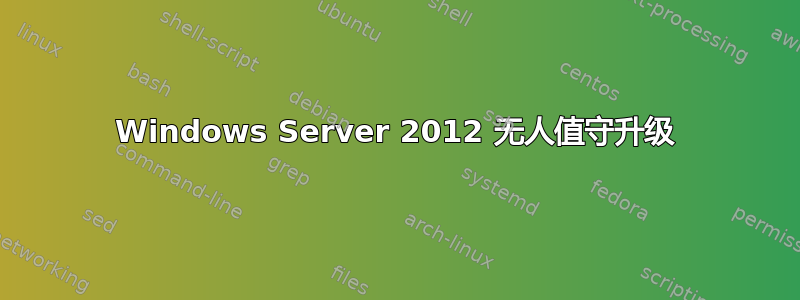
我是 Windows Server 软件的新用户,目前我们正在使用 Windows Server 2008 R2 数据中心。我们想升级到 Server 2012。
我们如何在 Windows 服务器上执行无人值守升级。我们无法物理访问此服务器。我找到了有关如何执行无人值守安装(磁盘擦除非升级)的说明,但我们如何升级?
答案1
根据上述建议,我这样做了。
- 在虚拟机中安装了Windows Server 2008R2的演示版本。
- 获取windows server 2012R2的Demo版本
- 关注了这篇文章Windows 服务器 2012 无人值守(必须进行一些调整才能添加 IP)
使用此站点作为附加属性的参考:Windows Server 2012 自动安装设置
并且我可以通过 RDP 会话成功将 Windows 2008R2 自动升级到 2012R2。
简而言之,步骤如下:
- 搜索 Windows ADK(评估和部署工具包)(adksetup.exe 至少版本 8.100.26866)
- 运行安装时选择部署工具和 Windows 预安装环境 (Windows PE)。
- 安装后打开:Windows 系统映像管理器。(从开始菜单)
- 您需要访问 ISO 并找到 install.wim 源文件(通常位于:[iso]\sources)
- 创建图像时,您需要选择要使用的操作系统版本。
- 图像准备好后,您需要开始将不同的设置添加到配置中。
复制配置示例并将其命名为自动无人值守文件根据需要进行更新(使用工具或记事本,推荐使用工具)执行升级,您将需要:[windows source]\setup.exe /unattend:"\path\OS\Autounattend.xml"
配置示例
<?xml version="1.0" encoding="utf-8"?>
<unattend xmlns="urn:schemas-microsoft-com:unattend">
<settings pass="specialize">
<component name="Microsoft-Windows-Shell-Setup" processorArchitecture="amd64" publicKeyToken="31bf3856ad364e35" language="neutral" versionScope="nonSxS" xmlns:wcm="http://schemas.microsoft.com/WMIConfig/2002/State" xmlns:xsi="http://www.w3.org/2001/XMLSchema-instance">
<ComputerName>mysuperComputer</ComputerName>
<ProductKey>123-1234-12345-12345-XXXX</ProductKey>
<RegisteredOrganization>Somewhere</RegisteredOrganization>
<RegisteredOwner>Me</RegisteredOwner>
<TimeZone>Pacific Standard Time</TimeZone>
</component>
<component name="Microsoft-Windows-TerminalServices-LocalSessionManager" processorArchitecture="amd64" publicKeyToken="31bf3856ad364e35" language="neutral" versionScope="nonSxS" xmlns:wcm="http://schemas.microsoft.com/WMIConfig/2002/State" xmlns:xsi="http://www.w3.org/2001/XMLSchema-instance">
<fDenyTSConnections>false</fDenyTSConnections>
</component>
</settings>
<settings pass="windowsPE">
<component name="Microsoft-Windows-International-Core-WinPE" processorArchitecture="amd64" publicKeyToken="31bf3856ad364e35" language="neutral" versionScope="nonSxS" xmlns:wcm="http://schemas.microsoft.com/WMIConfig/2002/State" xmlns:xsi="http://www.w3.org/2001/XMLSchema-instance">
<SetupUILanguage>
<UILanguage>en-US</UILanguage>
</SetupUILanguage>
<InputLocale>en-US</InputLocale>
<SystemLocale>en-US</SystemLocale>
<UILanguage>en-US</UILanguage>
<UserLocale>en-US</UserLocale>
</component>
<component name="Microsoft-Windows-Setup" processorArchitecture="amd64" publicKeyToken="31bf3856ad364e35" language="neutral" versionScope="nonSxS" xmlns:wcm="http://schemas.microsoft.com/WMIConfig/2002/State" xmlns:xsi="http://www.w3.org/2001/XMLSchema-instance">
<UserData>
<ProductKey>
<Key>123-1234-12345-12345-XXXX</Key>
<WillShowUI>OnError</WillShowUI>
</ProductKey>
<AcceptEula>true</AcceptEula>
<FullName>Me</FullName>
<Organization>Me</Organization>
</UserData>
<ImageInstall>
<OSImage>
<InstallFrom>
<MetaData wcm:action="add">
<Key> /IMAGE/NAME</Key>
<Value>Windows Server 2012 SERVERSTANDARD</Value>
</MetaData>
<Path>\\SOMESERVER\Windows Server\install.wim</Path>
</InstallFrom>
<InstallTo>
<DiskID>0</DiskID>
<PartitionID>1</PartitionID>
</InstallTo>
</OSImage>
</ImageInstall>
<DiskConfiguration>
<WillShowUI>OnError</WillShowUI>
<Disk wcm:action="add">
<CreatePartitions>
<CreatePartition wcm:action="add">
<Order>1</Order>
<Size>1000</Size>
<Type>Primary</Type>
</CreatePartition>
</CreatePartitions>
<ModifyPartitions>
<ModifyPartition wcm:action="add">
<Active>true</Active>
<Extend>true</Extend>
<Format>NTFS</Format>
<Letter>C</Letter>
<Order>1</Order>
<PartitionID>1</PartitionID>
</ModifyPartition>
</ModifyPartitions>
<DiskID>0</DiskID>
<WillWipeDisk>true</WillWipeDisk>
</Disk>
</DiskConfiguration>
<WindowsDeploymentServices>
<Login>
<Credentials>
<Password>thisisasecret</Password>
<Username>Administrator</Username>
</Credentials>
</Login>
</WindowsDeploymentServices>
<UpgradeData>
<Upgrade>false</Upgrade>
</UpgradeData>
</component>
<component name="Microsoft-Windows-TCPIP" processorArchitecture="amd64" publicKeyToken="31bf3856ad364e35" language="neutral" versionScope="nonSxS" xmlns:wcm="http://schemas.microsoft.com/WMIConfig/2002/State" xmlns:xsi="http://www.w3.org/2001/XMLSchema-instance">
<Interfaces>
<Interface wcm:action="add">
<Ipv4Settings>
<DhcpEnabled>true</DhcpEnabled>
</Ipv4Settings>
<Identifier>1</Identifier>
</Interface>
</Interfaces>
</component>
</settings>
<settings pass="oobeSystem">
<component name="Microsoft-Windows-Shell-Setup" processorArchitecture="amd64" publicKeyToken="31bf3856ad364e35" language="neutral" versionScope="nonSxS" xmlns:wcm="http://schemas.microsoft.com/WMIConfig/2002/State" xmlns:xsi="http://www.w3.org/2001/XMLSchema-instance">
<RegisteredOrganization>-</RegisteredOrganization>
<RegisteredOwner>-</RegisteredOwner>
</component>
</settings>
<cpi:offlineImage cpi:source="wim:c:/temp/install.wim#Windows Server 2012 R2 SERVERSTANDARD" xmlns:cpi="urn:schemas-microsoft-com:cpi" />
</unattend>
答案2
我能够将我的任何 Server 2008R2 DC 服务器升级到 2012R2 DC,只需将 ISO 的内容复制到桌面,然后使用简单升级模式运行安装程序即可。我知道它不是无人值守的,但您将保持连接状态,直到需要重新启动。等待大约 5 分钟,您应该能够重新使用 RDP。
您需要先确保您的 Windows 更新是最新的。除非您先备份,并有足够的维护窗口来在最坏的情况下进行备份恢复,否则我不建议在生产服务器上这样做。


